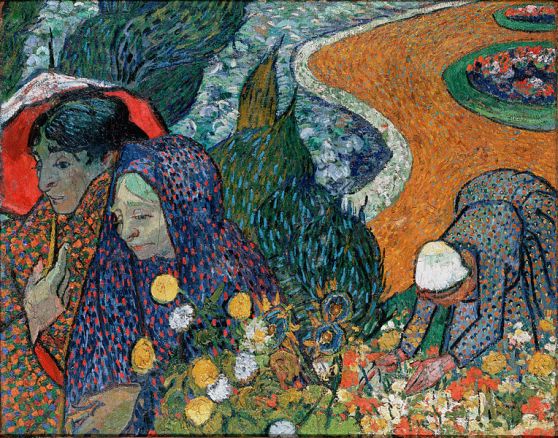VINCENT VAN GOGH: A SYMBOLIST LIFE’
ALAN TAYLOR

(In this extract Alan Taylor first quotes Albert Aurier, from an article in which Aurier described the Symbolist characteristics of Vincent’s work. Taylor then goes on to give his own interesting and concise thoughts on the meaning of the word – “Symbol”.
Alan Taylor is a lecturer on fine art, an artist, and a psychotherapist, living and working in North London)
‘Memory of the Garden at Etten (Ladies of Arles)’ 1888 (Hermitage Museum, St Petersburg).
The qualities which Van Gogh brought to his painting were analysed perceptively by the French art critic, Albert Aurier (1865 – 1892). Aurier was also a poet and member of the Symbolists group. In the first article ever written on Vincent van Gogh, which appeared in the inaugural issue of ‘Mercure de France’ in January 1890, he wrote,
“In the case of Vincent van Gogh – his choice of subjects, the constant harmony of the most excessive colours, the honesty in the study of his characters, the continuous
search for the essential meaning of each object, a thousand significant details unquestionably proclaim his profound and almost childlike sincerity, his great love of
nature and of truth – of his own truth. – This can be seen in the almost orgiastic excesses of everything that he painted; he is a fanatic, an enemy of bourgeois sobriety, and of
trifling details. – He is no doubt very conscious of pigment, of its importance and beauty, but also, and most frequently, he considers this enchanting pigment only as a marvellous
language destined to express an idea. Almost always he is a symbolist – feeling the constant urge to clothe his ideas in precise, ponderable, tangible forms, in corporeal and
material envelopes. There lies in practically all his canvases, for those who know how to find it, a thought, an idea. And this idea, the essential synthesis of his work, is also at
the same time its efficient and final cause. He had for a long time cherished the idea of inventing an art of painting that was very simple and popular, almost childlike, capable of touching humble people who do not care for subtlety.” (End of quote). Aurier concluded that great works of art should simultaneously be:
1. ideist, that is have an idea.
2. symbolic.
3. synthetist, that is have congruent forms.
4. subjective.
5. superbly decorative.
What do I mean by the word/term, symbol?
Philosophers, of course, have also envisioned nature as a reconciliation of the harmony of opposites, and conceived of art as a demonstration of these ideas. The aesthetic theories with which the symbolists became familiar are ancient Greek ideas about the effect on the psyche of forms and colours. The correspondences that bind the universe together make symbolism possible. The word symbol derives from the Greek roots esyni, meaning together, and eballieni, to throw. eSymboloni was the name given to a bone broken by friends into two parts that were kept as tokens of their emotional union, and esymboli has therefore always signified both the physical and spiritual aspects in joining together separate parts to a unified whole. The symbol restores something incomplete to its original state of integration by reconnecting the individual to the world by synthesising matter and spirit, form and idea. Most cultures have perceived symbols as having religious implications. A symbol conceals something yet is a revelation. A symbol is an unconscious invention in answer to a conscious problem, and a very powerful communication, such as for example, the Christian sacrament